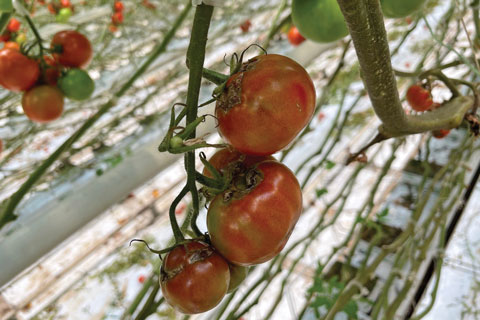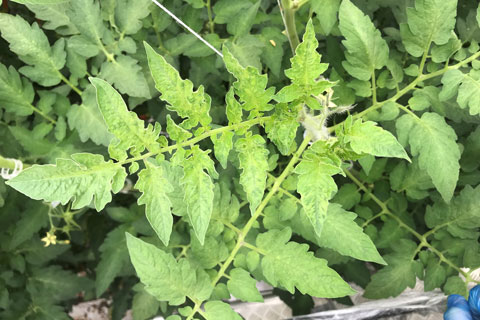6/1/2022
ToBRFV: The Fight for the World’s Tomatoes
Saman Soltaninejad

The tomato (Solanum lycopersicum L.) is one of the most economically important vegetables in the world, with an estimated production of 182.3 million metric tons in 2017 alone.
In recent years, a novel tobamovirus called Tomato brown rugose fruit virus (ToBRFV) has caused problematic outbreaks around the globe. This virus was discovered first in 2014-2015 in Jordan and Israel. Due to its unique resilience and adaptations—such as resistant-breaking traits, seed-borne and mechanical transmission, and environmental stability—ToBRFV has become a serious threat to crop production globally. ToBRFV outbreaks in greenhouse tomatoes have been reported in China, Egypt, Africa, Germany, Italy, Greece, Turkey, Mexico, the United Kingdom, Canada and the U.S.
Figure 1: Symptoms caused by ToBRFV on TOV tomato cultivar include symptomatic mosaic patterns on top of tomato plants (shown) with more on young leaves. It also includes deformation (needlelike) symptoms on younger leaves on side shoots.
Although there’s no known insect vector proven to transmit tobamoviruses, insect pollinators, including bumblebees and honeybees, have been shown to spread tobamoviruses. This virus spread is likely through mechanical wounding due to buzzing pollination. Once introduced to a production field or a greenhouse, a tobamovirus can remain infectious for a few years on contaminated surfaces, such as agricultural tools and machinery, irrigation water, and contaminated plant debris. Healthy plants can easily become infected through contact by contaminated hands, cutting tools and dirty clothing in plant-handling practices.
Symptoms to watch for
A wide range of ToBRFV symptoms can be observed on various parts of the plant, such as its leaves and fruits. Other viruses—such as pepino mosaic virus (PepMV), physostegia chlorotic mottle virus (PhCMoV), ToMV and TMV—cause similar (non-specific) leaf and fruit symptoms, and may be confused with ToBRFV symptoms.
Leaves: Pale chlorotic patches accompanied by a mosaic pattern, typically on top of the plant on younger leaves, causes wilting of leaves followed by yellowing and death. Another typical symptom on tomato leaves is deformation: (needlelike) younger leaves on side shoots and the head of the plant.
Stem, petioles and calyces: In severe cases, brown necrotic lesions may be observed.
Fruits: ToBRFV’s impact on fruits can vary greatly. Deformation, uneven ripening, a smaller number of fruits per truss, and blotchy and chlorotic spotting are just some of the potential symptoms. Sometimes, the visible symptoms of ToBRFV are similar to those of plants infected by the pepino mosaic virus (PepMV). Infected fruits could be unmarketable and poor in quality.
Symptoms on pepper fruits are not as severe as on tomato plants, and could be subject to mixed infections and require further investigation.
Detection and inspection methods
Inspection: The first step in detecting the virus is visual inspection. It’s sometimes possible to observe the symptoms on susceptible varieties at the time of growing, however, symptomless varieties make detection of the virus nearly impossible.
Identification: Visual detection is never enough to confirm the presence of ToBRFV. The first step for growers in-house is to use test strips for preliminary identification. In the past, cross-reaction with other tobamoviruses had caused confusion for growers relying on test strips. Recently, there are test strips specific to ToBRFV that have little to no cross-reactions with other tobamoviruses. Agdia ImmunoStrip is one of the most commonly used test strips in tomato greenhouses. Further molecular testing is needed following this test for regulatory confirmations of ToBRFV.
Generic RT-PCR tests could be used for preliminary identification, but they may also detect other tobamoviruses. Hence, selective and specific molecular tests should be used for detection of ToBRFV. Several specific molecular tests have been described for the identification of ToBRFV. After amplification by generic RT-PCR, sequencing should be performed to identify ToBRFV.
Movement pathways
The transmission of ToBRFV is mainly human-assisted and mechanical in nature. Moving infected plant materials—such as fruits and seeds—or using infected tools or surfaces can spread this harmful virus with ease.
We must assume natural dispersal of the virus: pollinators (birds and bees) and water circulating the virus within a production area. But what are other pathways of its wide spreading? These avenues are either local or international in scope.
 Figure 2: Symptoms caused by ToBRFV on TOV tomato cultivar; smaller fruits per truss, blotchy and chlorotic spotting with dried peduncles and calyces.
Figure 2: Symptoms caused by ToBRFV on TOV tomato cultivar; smaller fruits per truss, blotchy and chlorotic spotting with dried peduncles and calyces.
Locally, the role of containers and waste disposal dumpsters is critical and can’t be ignored. In most cases, these disposal bins are circulating between farms in a region before disposal, risking mass contamination. Infected waste containers, once emptied, remain a threat to crops and uncontaminated farms nearby, which often share waste management services. This situation is exacerbated further in areas with greater rainfall. Contaminated dumpsters at virus-free farms may become rapidly infected by the run-off rainwater from the base of an infected dumpster. Water-borne, the resilient virus can infect the work area, tools and machinery, clothing and workers, and other surfaces necessary for operations.
Another local pathway to consider is the high traffic of boxes and containers used to ship goods both to and from local suppliers. A great example of this is fertilizer bins and totes that rotate among many farms in a region through supplier companies. If these bins aren’t properly disinfected before re-use, then transportation and recycling of containers could cause a cascading effect in a region, ultimately wiping out production.
In terms of international pathways, containers promise the same problems, but on a greater scale. Shipping crates and trucks used to transport infected fruits (even when empty) can spread the virus to new states, countries and continents. The virus, though perhaps less likely, can be transmitted by experts and workers who visit multiple farms or travel between countries. Unregulated markets, illegal shipping and trading, and even physiologically-asymptomatic fruit distribution, can cause massive outbreaks.
Eradication methods
The lack of commercially available resistant cultivars makes control of ToBRFV nearly impossible. Growers must take severe preventative measures to decrease the risk of crop loss. However, not enough reliable information exists to determine which disinfectants effectively safeguard against the introduction of the virus.
Restricting access to the production area is the first step in biosecurity protocols against ToBRFV contamination. Once the first contaminated source is observed, complete removal and disposal of all materials associated with the infected plant—such as debris, string and growing media—must be conducted properly and thoroughly.
Appropriate and full disposal is critical to limit the spread of the virus. It’s vital that local governmental organizations design specific landfills or solutions for this matter, as it threatens the health of entire industries. Deep burial, burning and steaming are some examples of effective disposal methods. Composting is insufficient for the secure inactivation of the virus (Richter et al., 2019).
After disposing and removing infected plants, sanitary measures are then required. Associated tools and equipment should be disinfected with a virucidal agent. Additional hygiene measures include installing a disinfectant station and mat at the entrance of the greenhouse, cleaning the greenhouse with water and detergent to remove traces of organic matter, and disinfecting all surfaces in and on the greenhouse.
Since pollinators are likely a transmissive pathway, it may be necessary to remove potentially contaminated beehives from infected plant lots and replace them with new colonies.
Sanitary measures
Recently, the efficacies of competing commercial disinfectants against ToBRFV were evaluated in a large study. From the results obtained, the list was narrowed to a few disinfectants with broad-spectrum effects against ToBRFV and CGMMV. These disinfectants include Clorox (1%), Lactoferrin (.5%), Virkon (2% against CGMMV and 3% against ToBRFV), Virocid (2% and 0.5%), and Virex (3% against ToBRFV). These results were consistent with previous studies using other plant virus pathosystems, suggesting that some or all of these selected disinfectants may have a broader effect against other viruses.
Using disposable clothing and footwear, and changing them between production zones is a good step to reduce the spread of the virus. ToBRFV can survive for long periods on a range of surfaces—including skin and gloves, hard plastic, glass and concrete, and more. In general, one-minute handwashing is required to effectively remove the virus, but the most important practice is changing gloves regularly and disinfecting tools that have been used at infected plant areas.
The future of tomato production
Recently, ToBRFV-resistant genes have been discovered: Twenty-eight IR genotypes, among which represent commercial varieties, and one HR genotype. This is great news and a rather promising development for tomato growers, who can expect to see commercially viable ToBRFV tomato seeds be introduced to the global market in the years to come. IG
 Saman Soltaninejad is a commercial agriculture specialist in the Fluence Horticulture Services team. He’s a plant protection specialist with a demonstrated history of working in horticulture and vegetable production, with emphases in molecular biology, cell culture, IPM and biological control, cultivation and plant health. Fluence creates powerful and energy-efficient LED lighting solutions for commercial crop production and research applications. Find out more at https://fluence.science.
Saman Soltaninejad is a commercial agriculture specialist in the Fluence Horticulture Services team. He’s a plant protection specialist with a demonstrated history of working in horticulture and vegetable production, with emphases in molecular biology, cell culture, IPM and biological control, cultivation and plant health. Fluence creates powerful and energy-efficient LED lighting solutions for commercial crop production and research applications. Find out more at https://fluence.science.